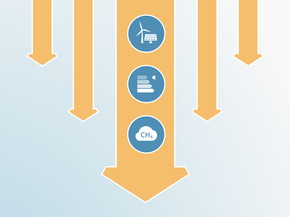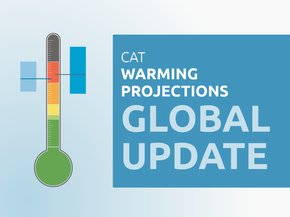Current Policy Projections
Current policies overview
While Kazakhstan recognises the need to transition into a greener future, currently implemented policies are not yet sufficient to meet its targets and would lead to emissions of 376 MtCO2e by 2020 (a reduction of 3% compared to 1990 levels, excluding LULUCF) and 419 MtCO2e by 2030 (an increase of 9% compared to 1990 levels). The current policy landscape prioritises energy sector emissions given that energy-related activities account for 85% of the country’s annual GHG emissions.
Energy supply
Kazakhstan’s economy is heavily reliant on fossil fuels: in 2017 around 10% of Kazakhstan’s GDP was dependent on oil revenues, around 70% of merchandised exports are fuel (World Bank, 2019a) and it belongs to the top 14 countries endowed with large natural gas reserves (Central Intelligence Agency, 2019). Natural gas production increased twofold from 2013–2016. Close to 89% of electricity was generated from fossil fuels in 2017; with coal accounting for around 70% of electricity generation, and natural gas for around 19% (IEA, 2019).
These sources of energy are complemented by hydro energy, which accounts for around 11% of electricity generation (IEA, 2019). Other renewables have started to make a contribution in recent years, and the share of renewable energy sources in primary energy supply has increased from 0.5% in 2012 to 0.9% in 2016 (Ministry of Energy of the Republic of Kazakhstan, 2017). In 2017, the share of renewable sources in primary energy supply reached 1.3%, based predominantly on hydro sources accounting for 1.1% of the total (IEA, 2019).
Besides efforts to transform its energy mix, Kazakhstan recognises the need for energy efficiency, and includes targets in its “Concept for Kazakhstan’s Transition to Green Economy” adopted in 2013 to decrease the energy intensity of GDP by 25% by 2020 and 50% by 2050 below 2008 levels (Republic of Kazakhstan, 2015). Measures are cross-sectoral in nature, and range from initiatives for district heating to thermal renovation of houses, to various energy standards and energy efficiency categories for buildings and household appliances.
Kazakhstan’s “Green Economy Concept” also sets the target of providing 30% of electricity generation from alternative and renewable energy sources (including nuclear) by 2030 and 50% by 2050, and reducing current CO2 emissions in electricity production by 40% by 2050, while also increasing the share of gas power plants to reach 30% by 2050 (Republic of Kazakhstan, 2015).
Along with the Action Plan for the Development of Alternative and Renewable Energy for 2013–20, adopted in 2013 to generate 31 renewable energy projects with a combined capacity of 1,040 MW (IEA, 2015), in November 2016 the government announced target indicators for the development of the renewable energy sector. These targets include renewable energy contributing 3% to total electricity production by 2020; and total installed capacity of renewable energy of 1,700 MW by 2020 being made up of wind power (933 MW), solar power plant PV (467 MW), hydroelectricity power plants (290 MW) and biogas plants (10 MW) (Republic of Kazakhstan, 2016b).
In September 2019, the Government of Kazakhstan announced that the country has currently 900MW of installed capacity in renewable energy but reaffirmed the 50% target of alternative and renewable energy share in electricity by 2050 (The Astana Times, 2019a). That same month, the Italian Eni was awarded the third renewable energy auction being held in Kazakhstan (following the first two auctions held in 2018) to build a 48MW wind power plant in the Northern Zone and expected to be finalised by 2022 (Eni, 2019).
Public finance flows for renewable energy have been increasing significantly in the past years, growing from USD 1.33 Million in 2010 to USD 145.93 Million in 2018 (IRENA, 2019), and the European Bank for Reconstruction and Development (EBRD) recently approved a EUR 300 Million extension of Kazakhstan Renewables Framework to support solar, wind, hydro, biogas, distribution and transmissions projects. The first phase had supported the creation of 262 MW of renewable power-generation capacity across the country (EBRD, 2019).
By growing its clean energy portfolio, Kazakhstan is tapping into its abundant renewable potential, estimated at more than 1,000 TWh per year (IEA, 2015). Yet, as a country richly endowed with fossil fuels, the transition has been slow in the past, and a more stringent effort is needed in order for Kazakhstan to achieve its climate targets.
Plans to expand coal and oil production deepen, and increase Kazakhstan’s dependence on fossil fuels. The volume of coal production amounted to 52 million tonnes and the volume of oil and condensate increased to 45.2 million tonnes by June 2018, a 5.1% and 6.2% increase relative to the same period last year respectively, reaching a record level compared to the past 10 years (“Refineries in Kazakhstan increasing production volumes,” 2018) (Kazenergy - Kazakhstan Association of oil; gas and energy sector, 2019). These trends are likely to continue, with ministerial statements indicating a likely increase of oil production to more than 100 million tonnes in 2025 (The Times of Central Asia, 2018). The government also plans to expand the energy sector to include coalbed methane exploration and production in the Karaganda region (kazinform, 2018) and in July 2019 signed a 15 year extension to the production sharing agreement of the Dunga fields, from 2024 to 2039, which will allow the production of an additional nine millions tons of oil (The Astana Times, 2019b).
These actions fail to acknowledge the short-term steps necessary to keep the window open for a 1.5°C-consistent GHG emissions pathway. For Eastern Europe and the former Soviet Union, coal power generation should be phased out by 2030, and globally by 2040 at the latest (Climate Analytics, 2019). Prioritising the modernisation of existing coal plants, as well as plans to replace coal with natural gas is short-sighted, considering that gas is not a long-term solution for the deep decarbonisation needed (Climate Action Tracker, 2017).
The government estimates that the transition to a green economy will be accompanied by substantial economic and societal benefits: by 2050, it is expected to create more than 500,000 jobs, develop new industries and living standards improve the quality of life (Ministry of Energy of the Republic of Kazakhstan, 2017; Republic of Kazakhstan, 2015). The costs are valued at USD 3-4 billion or about 1% of GDP per year (IEA, 2015).
To achieve its long-term targets, Kazakhstan will also need to become an attractive investment option for private investors. To this end, Kazakhstan already reformed its energy tariffs, which have been regarded as one of the key reasons for underinvestment (International Crisis Group, 2011). In January 2019, a capacity market was launched by the government with a feed-in tariff divided into two parts: an electric energy tariff (variable) and capacity tariff (fixed) (Mondaq, 2019).
The Government has also launched the Solar Resources Atlas, a website mapping Kazakhstan’s solar energy potential for the public to view in order to help with investment decisions (“AtlasSolar,” 2017). A handful of large-scale projects have been announced, suggesting that these policies have had some impact, however, most investments are through development finance institutions.
Other sectors
After a temporary suspension, the Emissions Trading Scheme restarted operation on 1 January 2018 with new allocation methods and trading procedures for all market participants (International Carbon Action Partnership, 2018). It covers the power sector and centralised heating, extractive industries and manufacturing: oil and gas mining, metallurgy, chemical and processing industry (International Carbon Action Partnership (ICAP), 2019). The World Bank and the Ministry of Energy of Kazakhstan launched an online platform in February 2018, which allows online transmission and recording of GHG emissions data and trade. An emissions cap has been set for 129 companies for the period 2018–2020, by National Allocation Plan and is set to reduce by 5 percent by 2020 compared to 1990 (World Bank, 2019b). Previous phases of the ETS had limited impact, representing either a stabilisation of capped entities’ emissions by 2013 and 2014 (compared to 2010 and 2011 levels) or limited reduction (1.5% by 2015 compared to 2012 levels). Currently covered emissions include close to 50% of total GHG emissions. Kazakhstan should consider increasing the scope of its Emissions Trading Scheme and expanding it to all sectors.
Further analysis
Latest publications
Stay informed
Subscribe to our newsletter




